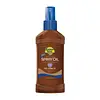What's inside
What's inside
 Key Ingredients
Key Ingredients

No key ingredients
 Benefits
Benefits

 Concerns
Concerns

 Ingredients Side-by-side
Ingredients Side-by-side

Butyl Methoxydibenzoylmethane 3%
UV AbsorberHomosalate 9%
Skin ConditioningEthylhexyl Salicylate 4.5%
UV AbsorberOctocrylene 2.4%
UV AbsorberParaffinum Liquidum
EmollientC12-15 Alkyl Benzoate
AntimicrobialCaprylyl Glycol
EmollientDiethylhexyl 2,6-Naphthalate
EmollientIsopropyl Myristate
EmollientCocos Nucifera Oil
MaskingVitis Vinifera Seed Oil
EmollientTheobroma Cacao Seed Butter
EmollientTocopheryl Acetate
AntioxidantHelianthus Annuus Seed Oil
EmollientZea Mays Oil
EmulsifyingAloe Barbadensis Leaf Extract
EmollientDaucus Carota Sativa Root Extract
Skin ConditioningMusa Sapientum Fruit Extract
Skin ConditioningPhenoxyethanol
PreservativeParfum
MaskingButyl Methoxydibenzoylmethane 3%, Homosalate 9%, Ethylhexyl Salicylate 4.5%, Octocrylene 2.4%, Paraffinum Liquidum, C12-15 Alkyl Benzoate, Caprylyl Glycol, Diethylhexyl 2,6-Naphthalate, Isopropyl Myristate, Cocos Nucifera Oil, Vitis Vinifera Seed Oil, Theobroma Cacao Seed Butter, Tocopheryl Acetate, Helianthus Annuus Seed Oil, Zea Mays Oil, Aloe Barbadensis Leaf Extract, Daucus Carota Sativa Root Extract, Musa Sapientum Fruit Extract, Phenoxyethanol, Parfum
Alcohol Denat.
AntimicrobialWater
Skin ConditioningParfum
MaskingMel
EmollientArgania Spinosa Kernel Oil
EmollientSodium Benzotriazolyl Butylphenol Sulfonate
UV AbsorberTris(Tetramethylhydroxypiperidinol)Citrate
StabilisingAlpha-Isomethyl Ionone
PerfumingCitronellol
PerfumingLimonene
PerfumingLinalool
PerfumingCoumarin
PerfumingCinnamyl Alcohol
PerfumingCitral
PerfumingGeraniol
PerfumingCI 19140
Cosmetic ColorantCI 14700
Cosmetic ColorantIngredients Explained
These ingredients are found in both products.
Ingredients higher up in an ingredient list are typically present in a larger amount.
Parfum is a catch-all term for an ingredient or more that is used to give a scent to products.
Also called "fragrance", this ingredient can be a blend of hundreds of chemicals or plant oils. This means every product with "fragrance" or "parfum" in the ingredients list is a different mixture.
For instance, Habanolide is a proprietary trade name for a specific aroma chemical. When used as a fragrance ingredient in cosmetics, most aroma chemicals fall under the broad labeling category of “FRAGRANCE” or “PARFUM” according to EU and US regulations.
The term 'parfum' or 'fragrance' is not regulated in many countries. In many cases, it is up to the brand to define this term.
For instance, many brands choose to label themselves as "fragrance-free" because they are not using synthetic fragrances. However, their products may still contain ingredients such as essential oils that are considered a fragrance by INCI standards.
One example is Calendula flower extract. Calendula is an essential oil that still imparts a scent or 'fragrance'.
Depending on the blend, the ingredients in the mixture can cause allergies and sensitivities on the skin. Some ingredients that are known EU allergens include linalool and citronellol.
Parfum can also be used to mask or cover an unpleasant scent.
The bottom line is: not all fragrances/parfum/ingredients are created equally. If you are worried about fragrances, we recommend taking a closer look at an ingredient. And of course, we always recommend speaking with a professional.
Learn more about Parfum